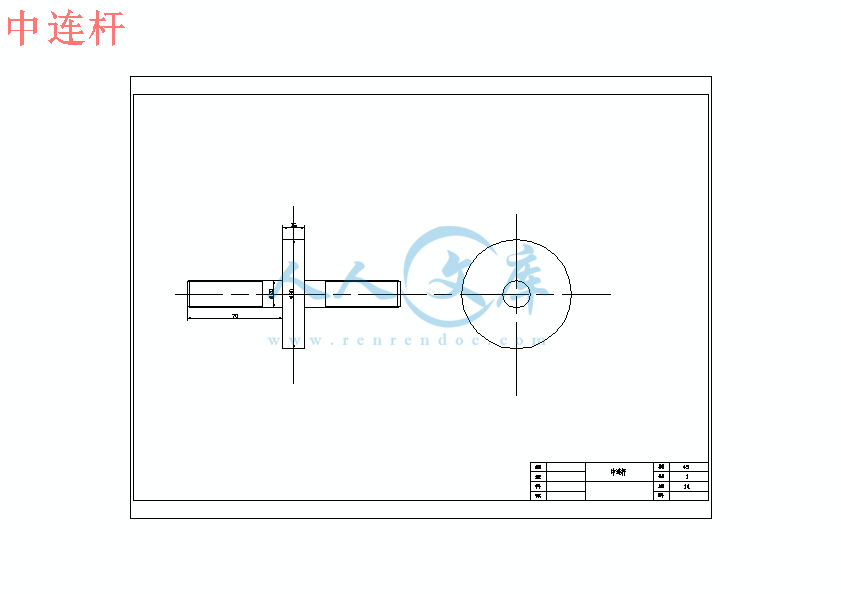高楼火灾救生装备设计
30页 12000字数+说明书+任务书+开题报告+7张CAD图纸【详情如下】
上连杆.dwg
中连杆.dwg
主动轴.dwg
从动轴.dwg
任务书.doc
外文翻译--齿轮和轴的介绍.doc
摇杆.dwg
板件.dwg
装配图.dwg
评阅表.doc
鉴定意见.doc
高楼火灾救生装备设计开题报告.doc
高楼火灾救生装备设计论文.doc







目 录
摘要……………………………1
Abstract………………………1
第一章 绪论…………………2
1.1设计背景及意义2
1.2国内外研究概况………3
1.3高楼逃生装置的实例4
第二章 整体方案设计6
2.1整体方案设计6
2.2装置的原理.........7
2.3装置的优点与不足8
第三章 装置零部件设计10
3.1轴的设计10
3.2齿轮设计13
3.3棘轮的设计16
3.4其他零部件的设计19
第四章 计算和验证20
4.1静力学平衡计算20
4.2绕绳计算21
4.3速度计算22
结论25
致谢26
参考文献27
摘 要
本文从开始介绍了高楼逃生装置的背景和研究意义,并对现有的一些高楼逃生装置进行了分析和对比,发现大多数的装置有成本高、机构复杂、安全系数低等一些不足之处。本设计根据机械创新理论,设计出一种基于负反馈闭环系统的高楼逃生装置,该装置具有成本低、操作简单、安全系数高、纯机械无电气结构等优点,最后通过对设计机构的零部件进行计算,得出整个机构的图形,在多次试验和计算之后,确定了不论是小孩还是老人都能从高楼平安降落到地面,达到了本次设计的目的。
关键词: 机械创新理论 负反馈闭环系统 高楼逃生器 纯机械无电气结构
Abstract
Firstly,this paper describes the background and significance of tall building escape device.And some of the existing tall building escape devices are analyzed and compared,most of the devices are costly, complex organization, the safety factor and low number of shortcomings are found. The design applied theory of inventive problem solving. To design a negative feedback loop system based on tall building escape device. The device has many advantages such as low cost, simple operation, high safety factor, purely mechanical no electrical structure. Finally, the components of the calculated design agency .The graphics get in the whole body ,after many tests and analysis, determining whether children or the elderly can safely descend to the ground from high buildings. the purpose of this design has achieved.
Key words: Machinery innovation theory Negative feedback loop system Tall building escape device Purely mechanical without electrical structure
第一章 绪论
1.1 设计背景及意义
随着建筑高度的增加和日趋密集,建筑的安全隐患也越来越多,即使在发达国家的高楼遇有火灾、爆炸等事件时,由于时间、空间等诸多因素的限制,人员自救逃生也是一个急待解决的重要问题。高楼火灾的有效救援和应急逃生,已经成为人们高度关注的社会问题。高层建筑一般功能较多,内部通道和外部环境情况复杂,一旦发生火灾,由于烟囱效应,火势和浓烟就会迅速扩大,很短时间内蔓延到内部楼梯和走廊,封锁正常的疏散通道,至使楼上被困人员无法逃生。所以逃生人员自救是一个亟待解决的重要问题。高楼突然失火或其他灾难发生时 ,电梯不能用,楼梯阻塞,而一般地面救援装备的举高和投射能力又远远的落后于高层建筑的高度发展而且装备体积庞大受道路交通,建筑周边环境等方面的影响因而延误救援时机,这样的情况每年都有发生 ,也有很多人因无法逃生而遇难,所以怎样快速有效的逃离火灾建筑成了决定生死的问题,而高楼逃生装置在这样的环境下应运而生。然而在人们将越来越多的精力和时间都投入到对安全问题保障研究的同时,却忽略了最基础的一种手段 ,在人们越来越多的用到各种高科技和现代手法进行安全保障的同时,却忽略意外事件的发生,是不可以借助外力和各种现代手段解决的 ,要靠最基础和最简单的方式 ,也就是机械传动的方式才是最安全和稳定的。
本课题要求针对高层建筑实际情况,设计一种在发生火灾情况下,能帮助人方便、快捷的逃生的工具。要求设计出的逃生器能适合各种结构的建筑物,运行实现自动化,并且要求操作方便,可以折叠,体积和重量在一个人可以操作的限度范围内。可以多次往返高层建筑进行营救。从而能最大限度的减少火灾中的人员伤亡。通过分析比较现有的一些高楼逃生器,大多数装置虽然能达到高楼逃生这一功能,但其结构原理复杂,操作繁琐,安全性差,生产成本高,部分装置还需要电力控制,局限性大(发生地震或火灾时很有可能断电,也不允许操作人员进行复杂的操作)。所以本设计采用一种基于负反馈闭环系统的高楼逃生装置,装置结构简单,操作简便,且无需电力或其他能源驱动,纯机械结构。其原理是利用逃生人员的重力,通过机构的转换,产生阻止逃生人员快速下落的阻力,随着下降中绕绳层数的减少,包角增大,阻力增大,使逃生人员依次有加速、匀速、减速下降的过程,最终以安全速度到达地面。装置的仰角大小可以人为调节。当从动轴与安全绳的粗糙度、安全绳的直径发生改变时可以通过改变仰角的大小使装置仍然可以正常使用,适应了各种环境。通过计算,结果达到预期要求,借助本装置逃生人员可以以安全的速度平稳的下落到地面。因而可以在灾难发生的时候保证人的生命安全。符合设计要求。
1.2国内外研究概况
在我国,目前主要的救生设备有逃生缓降器,这种设备主要针对普通家庭和个人使用,其构造由调速器、安全带、安全钩、钢丝绳等组成。每次可以承载约100公斤重的单人个体自由滑下,其下滑速度约为每秒1.5米,从二十层楼上降到地面约需40多秒/每人,根据人体重量的不同,略有差异。40秒虽然在平时看似不多,但在火灾逃生分秒必争的情况下还是略显漫长。目前这种逃生缓降器的使用状况不甚理想,其原因除家庭消防意识、经济因素之外,主要是难以适用老幼病残者,多户同时使用可能发生相互缠绕,以及安装问题、定期保养等,难以走进百姓家门。
还有一个主要的设备是救生气垫,它主要是一种利用充气产生缓冲效果的高空救生设备。一般采用高强度纤维材料,经缝纫、粘合制成,其气源一般采用高压气瓶。但是救生气垫仅限于高度为3-4层的楼房使用,随着高度的增加,其缓冲效果、作用面积也将大打折扣,同时此装备要求有相当大的窗户作为人们逃生的出路,在一定程度上受到很大的限制。因此应用范围非常有限,当然对于高楼逃生就有很大的危险性。 它包括一固定内凸轮(外径200mm),其特征在于所述的内凸轮型腔内设置有一导轨支架,所述的导轨支架的中部横向设置有滑动芯阀,所述的内凸轮型腔的内周壁由若干个依次连续并沿同一圆周均匀分布的拱形曲面组成,两相邻拱形曲面的交接处至内凸轮中心连线的延长线恰好通过延长方向所对的拱形曲面的顶点,所述的内凸轮型腔内过内凸轮中心点的径向线的长度与滑动芯阀的长度相等,所述的导轨支架体内设置有油腔,所述的滑动芯阀上下侧固定联接有位于油腔内的阻尼片。当内凸轮驱动滑动芯阀作往复横向移动时,使得油脂从油腔的一侧自缝隙翻越阻尼片流到油腔的另一侧,再从另一侧翻越阻尼片流回油腔的原侧端,在此过程中产生很大的阻尼,以此来限制内凸轮的速度。将该内凸轮与任何需要限速的回转件联接,即可达到自动限制该回转件转速的目的。
优点:体积小,无噪声,成本低,生产安装及维修方便,持久耐用,实用性高。
缺点:结构复杂,部件多,制造费工费时,下降速度不稳定,安全系数低。
1.3.2蜗轮蜗杆式高楼逃生装置
原理:利用蜗轮蜗杆的自锁性,蜗杆能带动蜗轮,但蜗轮不能带动蜗杆,使逃生人员在逃生过程中,控制自己的下落;
优势:结构简单;具有自锁性,安全性高,制造成本不高;
缺点:摩擦磨损大,材料要求高,操作复杂,普通人不易操作。
1.3.3心摩擦式高楼安全逃生器的设计
原理:重力带动卷轴转动,使得卷轴上的活动快由于离心力产生正压力,摩擦片与外壳产生摩擦力,在下降速度达到一定值,摩擦力矩与人体重力力矩平衡,匀速下滑;
优势:逃生人员下降过程中不需要人来控制;
缺点:局限性大重力越大下落到地面速度越大安全系数低且最小使用重量为20kg.第二章 整体方案设计
机械系统是由原动机、传动系统、执行系统、控制系统和其它辅助系统组成的,所以,机械系统总体方案设计的内容应是这几部分的方案设计及其各部分间的协调设计。即执行系统的方案设计、原动机类型的选择、传动系统的方案设计、控制系统的方案设计和其它辅助系统的方案设计。
机械系统整体方案设计的特点:1.协调性:整体系统由各个子系统组成,虽然各子系统的功能不同、性能各异,但它们在组合时必须按照整体功能的需要。2.相关性:构成系统的各要素之间也是互相关联的,它们之间有着相互作用、相互制约的特定关系。某个要素性能的变化将影响对相关要素的作用,从而对整个系统产生影响。3.内外结合性:任何系统必定存在于一定的社会和物质环境中,机械系统也不例外。环境的变化必将引起系统输入的变化,从而也将导致其输出的变化。 整体方案的设计包括了原动机、传动系统、执行系统、控制系统和其它辅助系统的设计。由于本设计是无需其他能源,仅依靠逃生人员的自身重力,所以没有使用原动机。传动系统选择了齿轮传动,齿轮传动-稳定,结构紧凑,而且使用双向传动,传动更加稳定,受力更加均匀,更能保证逃生人员的安全。控制系统主要有齿轮外侧的手柄。辅助系统主要有轴边棘轮机构和手柄机构,在轴上绕绳的时候更加方便。整个机构的立体图如上图:
参考文献
[1] 甘永立.几何量公差与检测[M].上海:上海科学技术出版社,2010.
[2] 孙训方.材料力学[M].北京:高等教育出版社,2010.
[3] 王铎.理论力学[M].北京:高等教育出版社,2009.
[4] 任家隆,李菊丽.机械制造基础[M].北京:高等教育出版社,2009.
[5] 邱宣怀.机械设计[M].北京:高等教育出版社,2008.
[6] 张策.机械动力学究[M] .北京:高等教育出版社,2007.
[7] 范思冲,周建平,丛肇助.画法几何及机械制图[M].北京:机械工业出版社,2006.
[8] 姜勇.AutoCAD中文版机械制图基础培训教程[M].北京:人民邮电出版社,2006.
[9] 霍达.高层建筑结构设计[M].北京:高等教育出版杜,2004.
[10] 朱龙根.机械系统设计[M] .北京:机械工业出版社,2004.
[11] 吕广庶,张远明.工程材料及成型技术基础[M].北京:高等教育出版社,2001.
[12] 朱龙根.简明机械设计零件手册[M].北京:机械工业出版社 2000.
 川公网安备: 51019002004831号
川公网安备: 51019002004831号